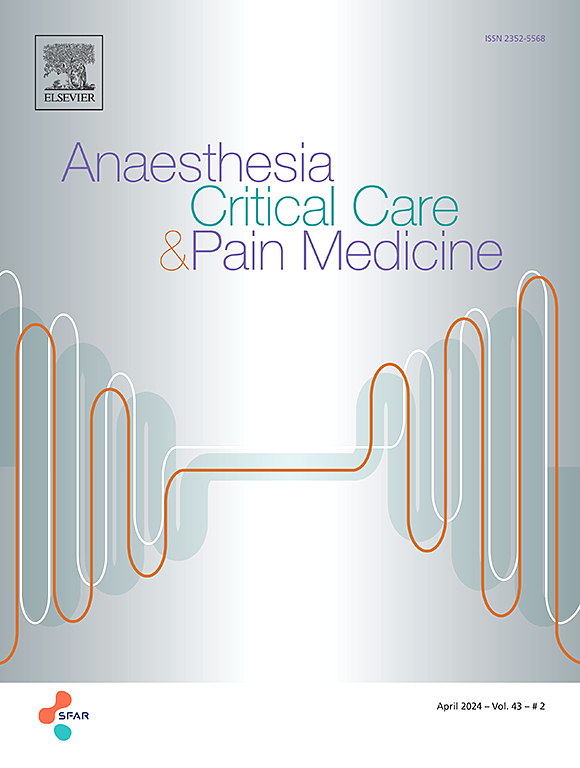重症监护病房重症COVID-19合并COPD患者的结局和死亡率预测因素:一项多中心研究
IF 4.7
3区 医学
Q1 ANESTHESIOLOGY
引用次数: 0
摘要
背景:COVID-19大流行期间入住重症监护病房(icu)的慢性阻塞性肺疾病(COPD)患者的高死亡率突出表明需要制定量身定制的临床管理策略。研究设计和方法:在REDCap中收集了55个西班牙icu中6512名COVID-19住院患者的流行病学、临床和实验室数据。患者被分为三组:COPD患者、其他慢性呼吸系统疾病(CRD)患者和无呼吸系统合并症(No CRD)患者。主要结果是确定90天死亡率的临床预测因素,重点是COPD组。采用倾向评分匹配(PSM)方法分析呼吸支持、生物标志物和免疫标志物的效果。结果:COPD患者(n = 328)的死亡率为50%,而其他慢性呼吸道疾病(CRD, n = 547)和无呼吸道合并症(No CRD, n = 5124)患者的死亡率为33%。在COPD患者中,95%的患者因COVID-19发生急性呼吸窘迫综合征(ARDS),使用高流量鼻插管(HFNC)与降低90天死亡率相关(风险比:0.54(95%可信区间[0.31 ~ 0.95])。在分子水平上,较低的IgG水平但较高的病毒载量和tnf - α、血管细胞粘附分子-1 (VCAM-1)和Fas细胞表面死亡受体(Fas)与COPD组的死亡率相关。结论:在COVID-19合并ARDS的COPD患者中,使用HFNC与较好的预后相关。慢性阻塞性肺病患者生物标志物和免疫标志物的失调及其与死亡率的关联表明需要进一步的靶向治疗策略。本文章由计算机程序翻译,如有差异,请以英文原文为准。
Outcomes and predictors of mortality in patients with severe COVID-19 and COPD admitted to ICU: A multicenter study
Background
High mortality rates among patients with chronic obstructive pulmonary disease (COPD) admitted to intensive care units (ICUs) during the COVID-19 pandemic highlight the need for tailored clinical management strategies.
Study Design and Methods
Epidemiological, clinical, and laboratory data were collected in REDCap for 6512 patients hospitalized with COVID-19 across 55 Spanish ICUs. Patients were stratified into three groups: those with COPD, those with other chronic respiratory diseases (CRD), and those without respiratory comorbidities (No CRD). The primary outcome was to determine clinical predictors for 90-day mortality, focusing on the COPD group. A propensity score matching (PSM) method was applied to analyze the effects of respiratory support, biomarkers, and immunomarkers.
Results
Patients with COPD (n = 328) exhibited a 50% mortality rate compared to 33% of those with other chronic respiratory diseases (CRD, n = 547), and those without respiratory comorbidities (No CRD, n = 5124). Among COPD patients, 95% of whom had Acute Respiratory Distress Syndrome (ARDS) due to COVID-19, the use of a high-flow nasal cannula (HFNC) was associated with reduced 90-day mortality (hazard ratio: 0.54 (95% Confidence Interval [0.31–0.95]). At a molecular scale, lower IgG levels but higher viral load and TNF-alpha, Vascular Cell Adhesion Molecule-1 (VCAM-1), and Fas Cell Surface Death Receptor (Fas) were associated with mortality in the COPD group.
Conclusions
In COPD patients with ARDS due to COVID-19, the use of HFNC was associated with a better prognosis. The dysregulation in biomarkers and immunomarkers in COPD patients and its association with mortality highlight the need for further targeted therapeutic strategies.
求助全文
通过发布文献求助,成功后即可免费获取论文全文。
去求助
来源期刊

Anaesthesia Critical Care & Pain Medicine
ANESTHESIOLOGY-
CiteScore
6.70
自引率
5.50%
发文量
150
审稿时长
18 days
期刊介绍:
Anaesthesia, Critical Care & Pain Medicine (formerly Annales Françaises d''Anesthésie et de Réanimation) publishes in English the highest quality original material, both scientific and clinical, on all aspects of anaesthesia, critical care & pain medicine.
 求助内容:
求助内容: 应助结果提醒方式:
应助结果提醒方式:


